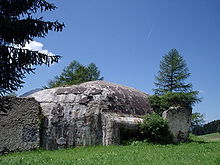Alpine wall in South Tyrol



The Alpine Wall in South Tyrol is the section of the Alpine Wall (German Alpine Wall ) in the years 1938 to 1942 as a fortified bulwark of Italy against the German Reich in South Tyrol was built.
Surname
In contrast to the other parts of the Vallo Alpino, the German name Alpenwall is often used for the South Tyrolean section . This is characterized by the geographical reference and some peculiarities compared to the Italian fortifications on the other borders. What is important here is the fact that this is not the German propaganda product Alpine fortress , although there were plans to include the unfinished bunker systems in a defense of the empire. Ultimately, however, the Western Allies concentrated on their advance on the western border and thus avoided fighting in the mountains. Most of the Alps were only occupied after the unconditional surrender of the Wehrmacht .
history
Italy's fascist dictator Benito Mussolini had the protective wall built against the southern Tyrolean border of the German Reich and thus against his most important ally, Adolf Hitler . Previously, the two states had sworn loyalty to each other with the “ Steel Pact ”. The construction work was not hidden from the German allies. German military personnel were allowed to visit facilities on the border with France; Her request to visit the building sites in South Tyrol, however, was rejected. The distrust was too great. There were solid reasons for this: The South Tyrol question was discussed very differently within the National Socialist leadership, which provoked a lack of clarity among the Italians with regard to the German attitude towards South Tyrol remaining with Italy. In addition, a very strong home-in-the-Reich movement formed in South Tyrol , which also posed a threat to the Italian northern border. The discussion was personally ended by Hitler by meeting Mussolini at the Brenner train station and announcing that the German Reich would respect the border and that South Tyrol would remain Italian. Nevertheless, the alpine wall was built, whereupon there were German protests. Ultimately, on October 4, 1942, Mussolini officially gave in to Hitler's insistence and ordered that all work on the Alpine Wall be finally stopped. After that, apparently only minor work such as completing the camouflage was carried out.
More than 350 infantry or artillery works were built in South Tyrol . However, many of them were not equipped with ventilation systems, power supply and armament. Only the barriers that were included in NATO's defense concept after 1945 were structurally completed and remained operational until the early 1990s. The bunker systems of the South Tyrolean Alpine Wall, like those of the entire Vallo Alpino, never had to withstand an attack. They are considered to be an example of the fact that fortifications played a role in strategic military planning even after the Second World War.
In 1999 the Italian state transferred numerous facilities to the ownership of the Autonomous Province of Bolzano - South Tyrol .
literature
- Alessandro Bernasconi, Giovanni Muran: Le fortificazioni del Vallo Alpino Littorio in Alto Adige . Temi, Trient 1999, ISBN 88-85114-18-0 .
- Florian Brouwers: Il Vallo Alpino - The Alpine Wall. In: Fortification. No. 12, 1998, ISSN 0931-0878 , pp. 5-22.
- Rolf Hentzschel: The Alpine Wall in South Tyrol. Helios, Aachen 2014, ISBN 978-3-86933-109-6 .
- Christina Niederkofler (Red.): Bunker . Published by the Autonomous Province of Bolzano - South Tyrol. Athesia, Bozen 2005, ISBN 88-8266-392-2 .
- Oliver Zauzig: The Vallo Alpino from Winnebach to Cortina d'Ampezzo. In: Fortification. No. 22, 2008, ISSN 0931-0878 , pp. 93-116.
